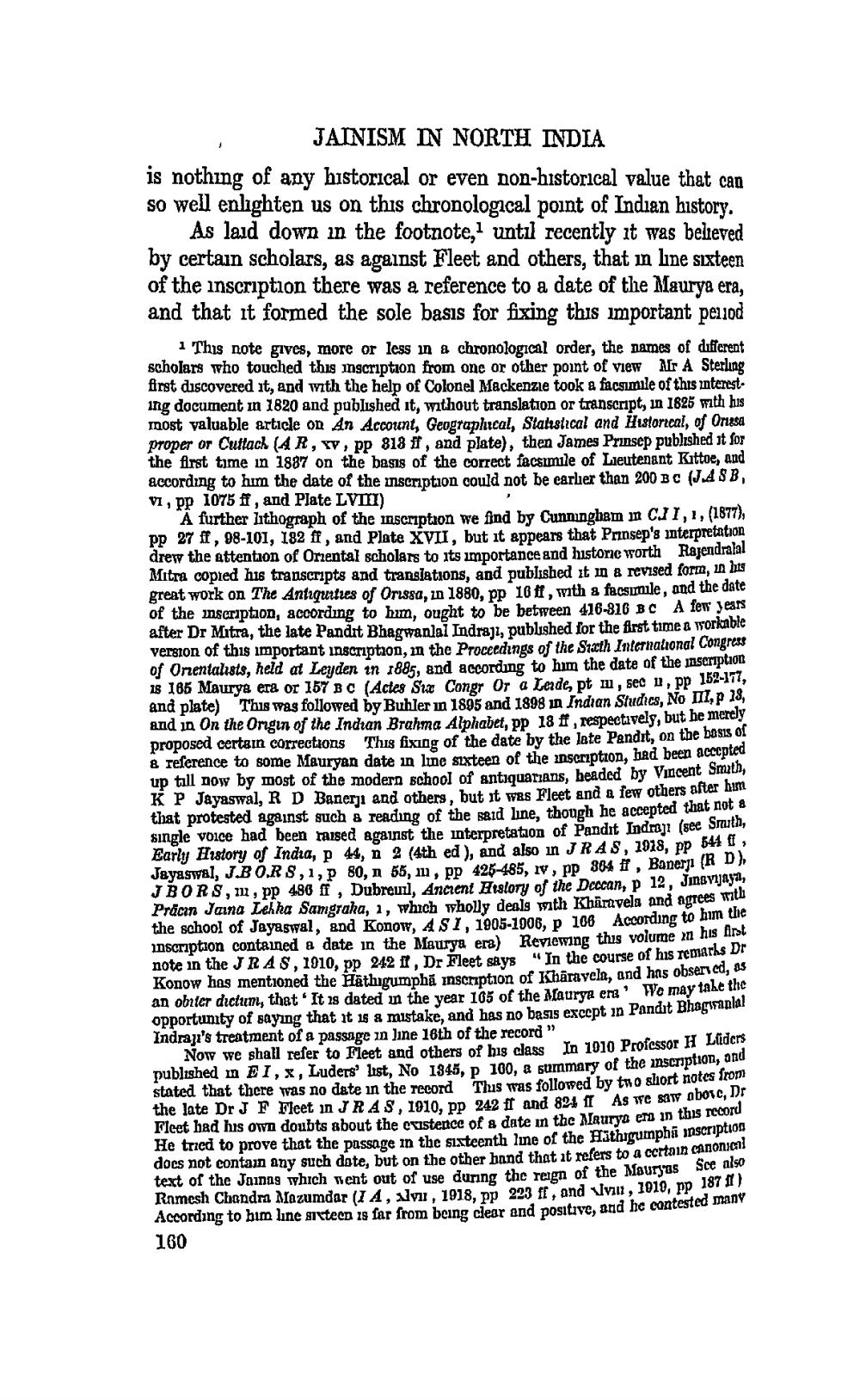________________ JAINISM IN NORTH INDIA is nothing of any historical or even non-historical value that can so well enlighten us on this chronological point of Indian history. As laid down in the footnote, until recently it was belteved by certain scholars, as against Fleet and others, that in line sixteen of the inscription there was a reference to a date of the Maurya era, and that it formed the sole basis for fixing this important period 1 This note gives, more or less in & chronological order, the names of different scholars who touched this inscription from one or other point of view Mr A Sterling first discovered it, and with the help of Colonel Mackenzie took a facsimile of this interest ing document in 7820 and published it, without translation or transcript, in 1825 with his most valuable article on An Account, Geographical, Statistical and Historical, of Orissa proper or Cuttach (AR, Y, pp 818 , and plate), then James Prinsep published it for the first time in 1887 on the bang of the correct facsimile of Lieutenant Kittoe, and According to him the date of the inscription could not be earlier than 200 BC (J.ASB, v1, pp 1075 1, and Plate LVIII) A further lithograph of the mscription we find by Cunningham in CJI, 1, (1877), Pp 27 11, 98-101, 182 ff, and Plate XVII, but it appears that Prinsep's interpretation drew the attention of Oriental scholars to its importance and histone worth Rajendralal Mitra copied his transcripts and translations, and published it in & revised forra, a bu great work on The Antiquities of Or2880, in 1880. pp 10 ff , with a facsimile, and the date of the scription, according to him, ought to be between 416-816 BC A few years after Dr Matra, the late Pandit Bhagwanlai Indraji, published for the first time a workable version of this important inscriptaon, in the Proceedings of the Stath International Congress of Onentalists, held at Leyden in 1885, and according to him the date of the inscription 18 166 Maurya era or 157 BC (Actes Six Congr Or a Leade, pt 7, sec 1, pp 152-: and plate) This was followed by Buhler in 1895 and 1898 in Indian Studies, No I P , and in On the Origin of the Indian Brahma Alphabet, pp 181respectively, but he merely proposed certain corrections This fixing of the date by the late Pandit, on the basis o! & reference to some Mauryan date in line sixteen of the inscription, had been accepic up till now by most of the modern school of antiquarians, beaded by Vincent si K P Jayaswal, R D Banerji and others, but it was Fleet and a few others after him that protested against such & reading of the Raid line, though he accepted that single voice had been raised against the interpretation of Pandit Indraji (sec Sraith, Early History of India, P 44, n (4th ed), and also in JRAS, 2018, PP 54 Jayaswal, J.BO.RS, 1, 80, 68, m. PD 425-485. 1, pp 864 ff, Banerji (RD) JBOR 8, 11, PP 486 T , Dubround, Ancient History of the Deccan, p 12, Jmevijaya, Procin Jaina Lehha Samgraha, 2, which wholly deals with Kharavela and agrees will the school of Jayaswal, and Konow, ASI, 1905-1006, p 166 According to him the inscription contained a date in the Maurya era) Reviewing this volurte za his note in the JRAS, 1910, pp 242 1, Dr Fleet says "In the course of his remaths Dr Konow has mentioned the Hithigumpba ingention of Kharavela, and has observed, A5 an obiter dictum, that. It is dated in the year 165 of the Mauryr er' We may take the opportunity of saying that it is & mistake, and has no basis except in Pandit Brasil Indraji's treatment of a passage in line 16th of the record ". Now we shall refer to Fleet and others of big class In 1910 Professor H Liders published in EI, X, Luders list, No 1345, P 100, & summary of the inscription, stated that there was no date in the record Thus was followed by thoshort notes the late Dr J F Ficet in JRAS, 1910, pp 242 fr and 824 1 As we saw obosc, Fleet had his own doubts about the ceistence of a date in the Maurys era in this recor He tried to prove that the passage in the sixteenth lme of the Hithrgutpha Inscription docs not contain any such date, but on the other hand that at refers to a certain CANON text of the Jains which went out of use during the reign of the Mouryas Sc Ramesh Chandm Mazumdar (I 4, Xyu, 1918, p 223 ff. and yill, 2010, pp 187 ! According to him line sisteen is far from being clear end positive, and he contested 160




